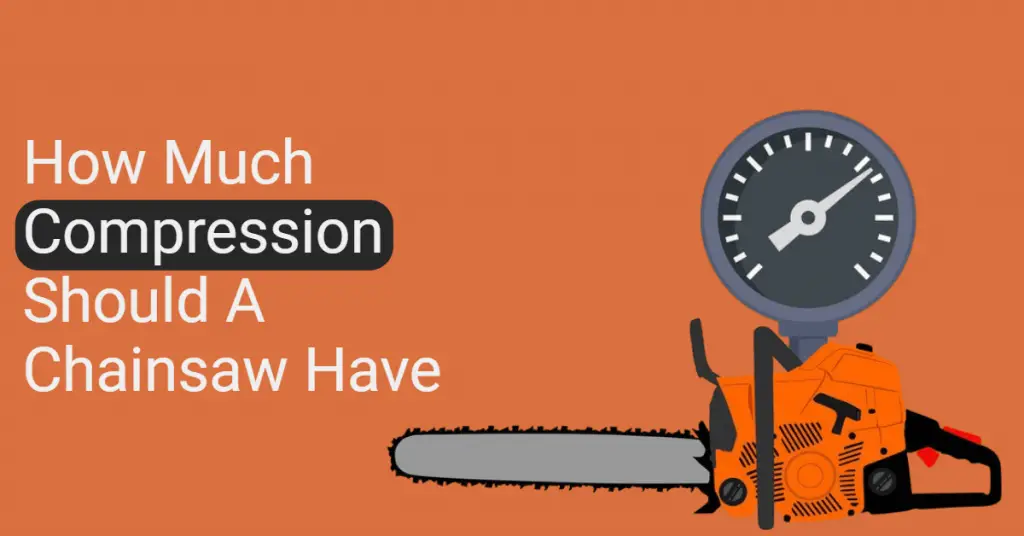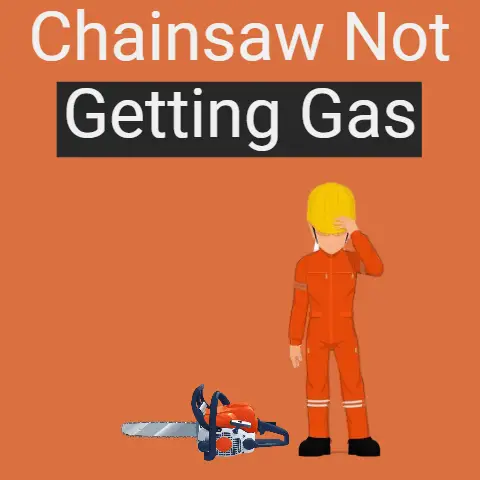How Much Compression Should a Chainsaw Have (Expert Guide)
The ideal compression level for a chainsaw varies depending on factors such as the brand, model, size, motor capacity, and temperature. If a chainsaw has a small engine, it requires a small amount of compression; if a chainsaw has a large engine, it will require a large amount of compression for running the chainsaw. However, a good general rule of thumb is that most chainsaws should have a compression reading of 110 PSI on a compression test gauge. Chainsaws with larger engines may have a compression reading as high as 160 PSI.
The Author
Is your chainsaw not getting started after 5-7 pulls of the rope? Is it also failed to make a promising pop?
You have installed a carb kit, changed spark plugs, and checked the ignition spark several times but still no luck!
The reason might be low compression. But how much compression is considered low or high? Does the compression amount play any role in maintenance and safety?
Chainsaws can be very dangerous if not properly maintained and used correctly.
One important aspect of chainsaw maintenance is ensuring that the chainsaw has the correct amount of compression.
If a chainsaw has too much compression, it can be overly powerful and cause damage.
You need to know how much compression a chainsaw should have to be the right amount.
We will look at the different factors that affect compression and the different tools that help measure compression.

Note:
If you think your chainsaw is not starting due to low compression, try the below things:-
- Pull the muffler and check the piston and cylinder for damage or a stuck ring.
- Pull the plug and dry it out.
- See if it will start then.
What is the ideal compression limit a chainsaw should have?
Smaller chainsaws: A smaller chainsaw will typically have a compression range of between 90 and 110 PSI.
Average-sized chainsaws: For most average-sized chainsaws, a good compression reading should be around 110 PSI.
Larger chainsaws: A bigger chainsaw will usually have a compression reading closer to 160 PSI.
2-stroke engines: Chainsaws usually have 2-stroke engines, and for these engines, the compression level should range from 100 to 160 PSI, with 100 to 110 PSI being the ideal range
A reading below 70 PSI indicates a bigger problem, and you may need to consult with a professional.
Chainsaw contains two types of engines, 2-stroke, and 4-stroke engines, and the engine uses gasoline as its fuel.
The compression varies according to the model and brand of each chainsaw.
If a chainsaw has a small engine, it requires a small amount of compression; if a chainsaw has a large engine, it will require a large amount of compression for running the chainsaw.
The temperature and motor capacity of the chainsaw defines the compression requirement levels of its engine.
For a 2-stroke engine, the minimum pressure level is within 100-160 psi, and maintaining the level within the 90-110 psi range is usually recommended.
Therefore, the ideal compression measurement for the 2-stroke engine is 100-110 psi.
If a new chainsaw has less than 100 psi, it will likely be tricky to start and, possibly, flood out easily.
Also, some individual engines might run lower or higher, so the temperature can vary and affect readings.
A cool chainsaw runs low, and the hot engine will be higher.
To check the compression of your chainsaw
To check the compression of your chainsaw, you can use either a compression test gauge or the thumb test method. The thumb test is not as accurate as using a compression test gauge, but it can provide a rough indication of the chainsaw’s compression level.
Here are the steps to check the compression of your chainsaw using a compression test gauge:
- Remove the spark plug by rotating it clockwise and then pulling it from the hole.
- Screw the compression test gauge into the spark plug hole, ensuring a tight seal.
- Gently pull the chainsaw’s starter rope multiple times until the needle on the gauge stops flicking. The point where the needle stops indicates the level of compression your chainsaw is producing.
If you don’t have access to a compression test gauge, you can attempt the thumb test method:
- Remove the spark plug by rotating it clockwise and then pulling it from the hole.
- Place your thumb over the hole that the spark plug initially filled.
- Gently pull the chainsaw’s starter rope. If the compression is sufficient, the pressure should push your thumb off the hole, and you shouldn’t be able to hold your thumb there.
6 Ways to fix low compression issue
To fix a chainsaw with low compression, you can follow these steps:
- Perform a compression test: Check the piston, rings, and cylinder by removing the spark plug and the muffler, and replace any problematic parts. You will need a compression gauge and appropriate tools for this.
- Check for air leaks: The most common cause of low compression in a chainsaw is an air leak in the cylinder head gasket or piston ring seal. Replace these parts if they are damaged.
- Inspect the spark plug: If the spark plug is worn out or the gap is too large, it can cause difficulties with starting the chainsaw. Replace the spark plug if necessary.
- Check the carburetor: If you are still experiencing problems after checking the above, there may be an issue with the carburetor. Adjust the carburetor screws according to the manufacturer’s instructions.
- Inspect the piston and cylinder: Look for scoring, galling, and carbon buildup on the piston skirt, as well as excessively worn or broken rings. If these parts are damaged, replace them.
- Check the gasket: If the gasket is damaged, it can cause air leaks and low compression. Replace the gasket if necessary.
Regular maintenance, such as tightening plugs and replacing worn-out parts, is crucial in preventing low compression and ensuring the longevity of your chainsaw. If you are unsure about any of these steps, it is recommended to consult a professional for assistance.
18 tips for keeping your chainsaw’s compression in good condition
Maintaining proper compression is crucial for the optimal performance of your chainsaw. Here are some tips to help you keep your chainsaw’s compression in good condition:
Regular Maintenance
Regular maintenance, including cleaning, lubricating, and adjusting the chainsaw, can help prevent compression issues. Follow the manufacturer’s recommendations for maintenance intervals and procedures.
Air Filter Care
A clogged air filter can restrict airflow and cause low compression. Clean or replace the filters as needed to ensure proper airflow to the engine.
Check the carburetor
A poorly adjusted or clogged carburetor can also contribute to low compression. Inspect the carburetor and clean or adjust it as needed to ensure proper fuel and air mixture.
Fuel Mixture
Using the correct fuel mixture for your chainsaw is essential for proper engine performance. Check the manufacturer’s recommendations and ensure you are using the correct fuel and oil mixture. Avoid using stale or improperly mixed fuel.
Fuel Quality
Use high-quality, fresh gasoline with the appropriate octane rating.
Proper Starting Technique
Use the proper starting procedure recommended by the manufacturer to avoid unnecessary strain on the engine.
Warm-Up Period
Allow the engine to warm up before subjecting it to heavy loads. This helps achieve optimal compression and reduces wear.
Avoid Flooding the Engine
Be cautious when starting the chainsaw. Over-priming or excessive choking can flood the engine and affect compression.
Regular Spark Plug Checks
Inspect the spark plug for fouling, wear, or damage. Replace it according to the manufacturer’s recommendations.
Maintain Exhaust System
A clogged or restricted exhaust system can cause low compression. Inspect the exhaust system and remove any obstructions or clean the muffler to ensure proper airflow.
Check Cylinder and Piston Rings
A worn or damaged piston or cylinder can also contribute to low compression. Remove the spark plug and inspect the piston and cylinder for any signs of damage or excessive wear. If you notice any issues, you may need to replace the piston or cylinder.
Check the compression release valve
Some chainsaws are equipped with a compression release valve that helps with starting the engine. If this valve is not functioning properly, it can cause low compression. Inspect the valve and ensure it is clean and moving freely. If necessary, replace the valve.
Check for air leaks
Air leaks can cause low compression in a chainsaw. The most common places for air leaks to occur are on the crankshaft seals. Inspect the seals for any signs of damage or wear and replace them if necessary.
Keep Fuel System Clean
Regularly inspect and clean the fuel tank, lines, and carburetor to prevent clogs that can affect compression.
Avoid Overworking the Engine
Avoid prolonged periods of high-speed operation without letting the engine cool down. Overheating can affect compression.
Store Properly
If storing for an extended period, use a fuel stabilizer and run the engine until it’s out of fuel to prevent stale fuel issues.
Regularly Inspect for Leaks
Check for any signs of oil or fuel leaks around the engine that could indicate a gasket or seal problem.
Professional Service
If you notice a significant drop in compression or encounter performance issues, it’s best to consult a professional for diagnosis and repair.
What should matter for the compressor of the chainsaw is moto-capacity in terms of temperature and cc.
Some compressor runs on low cc motors, and some compressors have high motor power, i.e. 150cc.
Moreover, for the chainsaw that runs around 50cc, there will be required compression is 140 to 150psi from the air compressor, and higher, you will need more compression from the air compressor that depends on the power motor.
There is one more thing for your information the cool chainsaw usually requests 85 to 100psi, and the hot chainsaw requests more than 150 to 160 psi from the compressor.
Understand the compression requirement of your chainsaw
You can understand the compression requirement with the pressure test. Now, look at how this test can function.
- The first step is to prepare your chainsaw by removing the spark plug, and you can use a notch and remove it; also, place the gauge on the spark plug area.
- The second step is to get an accurate reading from the seal, and you can do it by pulling the starter rope of the chainsaw; it will start working, and you will be able to see the needle that is moving.
- The final step is to take your final readings once you get a stable gauge number indicating the perfect compression needed to run your chainsaw.
Need of Compression for 2-stroke engine
For the fuel ignition, proper pressure and compression are required for chainsaws in the 2-strokes engine.
A two-cycle engine works with just a single-piston of cylinders. The cylinder piston goes here and there inside a shaft.
On the main stroke, the air is compacted on one side, and fuel is sucked in on the other.
On the subsequent stroke, the fuel is lighted and ignited on the bottom, and the exhaust is pushed out the top.
The compressed air from the principal stroke makes a vacuum that pulls in the fuel.
Without appropriate pressure, fuel can’t get sucked into the engine.
Final Thought
There is no definite answer to the question How Much Compression Should A Chainsaw Have?
You have to understand the compression level for your engine and the requirements of your chainsaw or do the pressure test to measure the compression needed to run the chainsaw.
Compression matters for the effective working of the engine.
You will understand the compression level range for working smoothly.
Chainsaw’s engine works smoothly and effectively as ideal, working at 110psi compression or pressure.
Choose the model of motor for working at standard compression.






